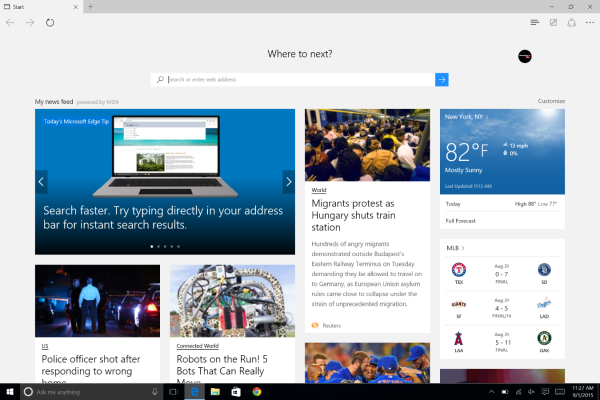Illuminating the Digital Night: A Comprehensive Guide on How to Enable Dark Theme in Microsoft Edge Browser

Introduction
As technology seamlessly integrates into various aspects of our lives, the visual interface of web browsers plays a pivotal role in shaping our digital experiences. Microsoft Edge, the default web browser in Windows 10, offers users the option to customize their browsing environment with the Dark Theme. This comprehensive guide aims to illuminate the steps on how to enable the Dark Theme in Microsoft Edge, providing users with a visually comfortable and aesthetically pleasing browsing experience during the day and night. Whether you’re prioritizing reduced eye strain, conserving energy, or simply embracing the sleek and modern look, this guide equips you with step-by-step instructions, optimization tips, and troubleshooting insights.
Understanding the Benefits of Dark Theme
1. Reduced Eye Strain:
- Dark Theme features a darker color palette, which can reduce eye strain, especially in low-light environments. The contrast between text and background is softer, creating a more comfortable reading experience.
2. Energy Conservation:
- For users on devices with OLED or AMOLED displays, Dark Theme can contribute to energy conservation. Dark pixels consume less power on these display technologies, potentially extending battery life on mobile devices.
3. Aesthetically Pleasing:
- Many users find the Dark Theme to be aesthetically pleasing. The sleek, modern design can create a visually immersive and sophisticated browsing environment.
4. Enhanced Focus on Content:
- The Dark Theme often places a greater emphasis on content, allowing text, images, and multimedia to stand out more prominently against the darker background.
Step-by-Step Guide on How to Enable Dark Theme in Microsoft Edge
1. Open Microsoft Edge:
- Launch the Microsoft Edge browser on your Windows 10 computer.
2. Access the Settings Menu:
- Click on the three horizontal dots in the upper-right corner of the browser window to open the menu.
3. Navigate to Settings:
- From the menu, select “Settings” to access the browser’s settings.
4. Choose Appearance Settings:
- In the left sidebar, click on “Appearance.” This section houses settings related to the overall look and feel of Microsoft Edge.
5. Select Dark under “Choose a Theme”:
- In the “Choose a theme” section, you’ll find the options “System default,” “Light,” and “Dark.” Select “Dark” to enable the Dark Theme.
6. Customize Additional Appearance Settings (Optional):
- Microsoft Edge offers additional appearance settings that you can customize. Explore options such as choosing the accent color or toggling between system default and Dark Theme based on your preferences.
7. Close and Relaunch Microsoft Edge:
- After making changes, close and relaunch Microsoft Edge to see the Dark Theme in action. The browser’s interface, including menus, tabs, and other elements, should now reflect the Dark Theme.
Tips for Optimizing Dark Theme Settings
1. Schedule Dark Theme Automatically:
- Microsoft Edge allows users to schedule Dark Theme to activate automatically during specific times. In the “Choose a theme” section, select “System default” to enable automatic switching between Light and Dark Theme based on your system’s dark mode settings.
2. Explore Theme Extensions:
- Explore the Microsoft Edge Add-ons Store for theme extensions that can further customize the appearance of your browser. Some extensions offer additional Dark Theme variations or themes with specific color schemes.
3. Adjust Contrast and Text Size:
- In the “Text Size” and “Page Zoom” sections within the Appearance settings, you can customize the contrast and text size to enhance readability according to your preferences.
4. Use Dark Theme Across Windows 10:
- Windows 10 features a system-wide dark mode. Enabling this dark mode in Windows settings will extend the Dark Theme to various system applications and interfaces, providing a consistent visual experience.
5. Consider Dark Mode in Websites:
- Some websites offer their own dark mode settings. Explore the settings or preferences within your favorite websites to enable dark mode for a cohesive experience.
Troubleshooting Common Issues
1. Inconsistent Dark Theme Activation:
- If the Dark Theme is not consistently activating, ensure that you have selected “Dark” under the “Choose a theme” section in Microsoft Edge settings. Additionally, check your system’s dark mode settings.
2. Browser Updates:
- Ensure that your Microsoft Edge browser is updated to the latest version. Browser updates often include improvements and bug fixes that enhance theme-related features.
3. Issues with Website Compatibility:
- Some websites may not display optimally in Dark Theme. If you encounter issues with website compatibility, consider switching back to Light Theme for those specific sites.
4. Adjusting Display Settings:
- If the Dark Theme appears too dark or too light, you can adjust the overall brightness and contrast settings of your display in your Windows settings.
Conclusion
Enabling the Dark Theme in Microsoft Edge is a simple yet impactful way to customize your browsing environment on Windows 10. This comprehensive guide, enriched with step-by-step instructions, optimization tips, and troubleshooting insights, aims to empower users to navigate these settings with confidence. Whether you’re prioritizing reduced eye strain, energy conservation, or embracing the sleek aesthetic, let this guide be your companion on the journey to a more visually comfortable and enjoyable browsing experience. As you explore the possibilities of the Dark Theme in Microsoft Edge, may your digital journey be illuminated by the elegance and efficiency of this customizable feature.




